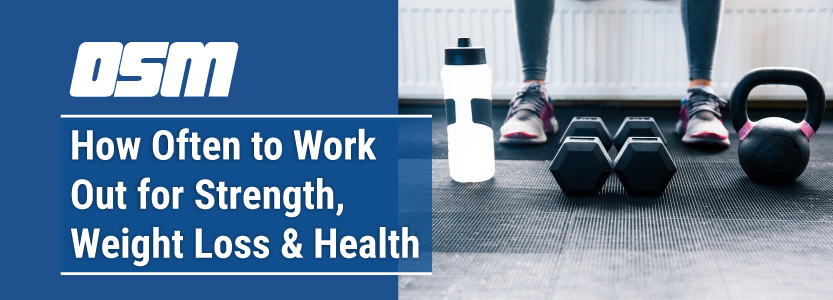How Often to Work Out for Strength, Weight Loss, and Health
Article featured on MedicalNewsToday
How often a person needs to work out to see results will depend on their fitness goals. Losing weight, building muscle, and increasing endurance and stamina each require a different approach to training.
Exercise has a range of important benefits. It enhances overall health, helps a person maintain moderate weight, relieves stress, and can promote restful sleep.
Due to this, what people wish to achieve through exercise differs among individuals. Some people may use exercise as a weight loss technique, whereas others may want to build their strength.
This article addresses how often a person should work out based on their particular goals.
It is advisable to consult a doctor before starting any workout or strength training program, as they can offer advice on how to work out safely and minimize the risk of injury.
How often to work out for weight loss
At its most basic level, weight loss is about solving a math problem.
A person must burn off more calories than they take in on a daily basis. Some of the ways a person can accomplish this include:
- eating fewer calories each day than they burn off
- increasing their physical activity to burn off more calories
- increasing their muscle mass so that they burn more calories at rest
There is controversy surrounding whether exercise alone is enough to achieve weight loss.
For example, some research suggests that exercise can cause the body to start to compensate by adjusting metabolism as a means to hold on to body fat.
Exercise still has a role to play in weight loss, but for maximum benefits, a person should combine it with a healthful calorie-controlled diet that reduces their calorie intake.
Researchers also note that continuing to exercise after weight loss can help stop people from regaining the weight.
The American Heart Association (AHA) recommend a combination of cardiovascular training and strength training to boost health and burn calories.
Cardiovascular training
The AHA recommend getting at least 150 minutes of moderate intensity activity or 75 minutes of vigorous activity throughout the week.
A person can also engage in a mix of moderate intensity and vigorous activities should they prefer.
Example of moderate intensity activities include:
- brisk walking at a speed of at least 2.5 miles per hour (mph)
- dancing
- gardening
- riding a bicycle slower than 10 mph
- tennis
- water aerobics
Examples of vigorous activities include:
- hiking, particularly uphill or while wearing a heavy pack
- jumping rope
- running
- swimming
- taking an aerobics class
- vigorous yard work, such as digging
Ultimately, a person can gain the greatest health benefits by engaging in at least 5 hours of physical activity a week.
Strength training
Strength training involves using resistance to build muscle.
Muscle can help make the body more metabolically active, increasing the rate at which it burns calories.
The AHA recommend engaging in moderate-to-high intensity resistance training on at least 2 days of the week. Examples of approaches to resistance training include:
- Lifting weights: This could involve using weight machines or free weights to perform exercises such as biceps curls, bench presses, and leg presses.
- Using body weight for resistance: Exercise examples include lunges, squats, and tricep dips. A person does not require any equipment to do these.
- Using resistance bands: Resistance bands are stretchy elastic bands that help increase the amount that a person’s muscles must work. Resistance bands vary in tightness, with tighter ones increasing the exercise intensity. A person can perform exercises such as squats, lunges, biceps curls, and triceps extensions using resistance bands.
Anyone who is new to exercise and unsure where to begin may wish to consult a certified personal trainer. A trainer can advise the individual on what exercises are suitable for their level of health and fitness, as well as how to perform them correctly and safely.
Summary
Exercise programs for enhancing aerobic capacity and building muscle strength can vary.
Often, the “best” exercise program is the one that a person is willing and able to perform on a routine basis.
With regular efforts and increasing intensity, a person should see their desired results over time.
The Orthopedic & Sports Medicine Center of Oregon is an award-winning, board-certified orthopedic group located in downtown Portland Oregon. We utilize both surgical and nonsurgical means to treat musculoskeletal trauma, spine diseases, sports injuries, degenerative diseases, infections, tumors and congenital disorders.
Our mission is to return our patients back to pain-free mobility and full strength as quickly and painlessly as possible using both surgical and non-surgical orthopedic procedures.
Our expert physicians provide leading-edge, comprehensive care in the diagnosis and treatment of orthopedic conditions, including total joint replacement and sports medicine. We apply the latest state-of-the-art techniques in order to return our patients to their active lifestyle.
If you’re looking for compassionate, expert orthopedic surgeons in Portland Oregon, contact OSM today.
Phone:
503-224-8399
Address
1515 NW 18th Ave, 3rd Floor
Portland, OR 97209
Hours
Monday–Friday
8:00am – 4:30pm




